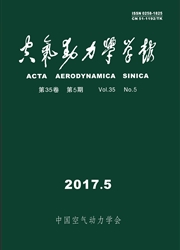

 中文摘要:
中文摘要:
采用数值模拟和工程计算相结合的方法对HTV2第二次飞行试验的热环境进行了复现,发现在40km以下,翼前缘驻点线会发生边界层转捩,引起前缘热流比层流情况增加55%,最大热流达到11MW/m^2,烧蚀量约为3mm,前缘高热流导致法向应力超过碳布层与层之间的粘接强度,而纵向应力小于碳布拉伸破坏极限。因此本文认为,HTV2第二次飞行试验失利的原因主要是:烧蚀叠加应力破坏,即在翼前缘由于烧蚀导致多层碳布被烧破,从而在翼前缘沿展向驻点线出现较长的破损口,而法向应力导致碳布层与层之间的粘接失去作用,在气动力作用下,可能从烧破的地方开始将碳布掀起,严重影响气动性能,最终导致飞行器无法控制。
 英文摘要:
英文摘要:
The second flight of the hypersonic technology vehicle 2 (HTV-2) tallecl on August 11, 2011. According to the engineering review board (ERB) analysis report, the most probable cause of the premature flight termination is unexpected aeroshell degradation, creating multiple upsets of increasing severity that ultimately activated the flight safety system. In order to investigate this failure, the aerothermodynamic environment, ablation, and stress are calculated and analyzed in this paper using numerical simulation and empirical calculation combined method, based on reconstructed HTV-2 configuration and the flight trajectory. It has been found that, at the height of 40 km, there is a possibility of boundary layer transition, leading to turbulent flow along the leading edge of the wing. Especially, due to the shock interaction, the transition moves forward, and the heating rates are 55~ higher than those with laminar flow condition at Z=200mm in spanwise direction at leading edge. The maximal value of cold wall heating rate reaches 11 MW/m2, and the ablation recession is approximately 3ram. Since the thickness of 2-D carbon cloth is only lmm, there are two to three layers of carbon cloth are burned up at body leading edge. At the same time, the normal stress exceeds the bonding strength between carbon cloth layers. The most probable cause for the termination of the HTV2 second premature flight can be concluded according to the present study. The aeroshell degradation process can be described as follows. An unexpected great ablation at the leading edge breaks several layers of the carbon cloth, resulting in a long breakage, meanwhile the normal stress invalidates the bonding between carbon cloth layers. Under the influence of aerodynamic force, several layers of the carbon cloth can be lifted up from the breakage. This behaviour hasa strong impact on the stable aerodynamically controlled flying, and finally activates the vehicles autonomous flight safety system to make a controlled descent and splashdown in
 同期刊论文项目
同期刊论文项目
 同项目期刊论文
同项目期刊论文
 期刊信息
期刊信息
